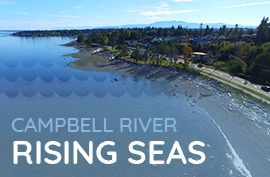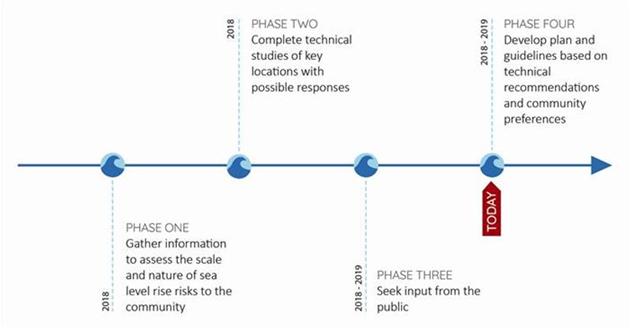
SEA LEVEL RISE
Sea level rise is an environmental shift witnessed globally over the past century. The atmosphere’s warming temperatures cause our ocean’s waters to warm and expand and cause glaciers and ice sheets on land to melt, resulting in sea level rise.
Rising sea levels and more extreme storms create increasing hazards like flooding and erosion for seaside communities. As seas continue to rise, the City of Campbell River is one of many coastal municipalities in British Columbia preparing to deal with increased flooding now, and in the future, as we adapt to our changing environment.
OUR STRATEGY
As a seaside community, the City of Campbell River has a history of storms and flooding in low-lying areas. With climate change, these will become more regular and more severe as higher seas push damaging storm surges further inland, weather events become more destructive, and heavier rainfall floods the Campbell River.
The Province of British Columbia advises communities to plan for one metre of sea level rise by the year 2100, and two metres by 2200. Preparing for this is an on-going process, and a combination of solutions will be considered, including re-evaluating land-use, structural and non-structural adaptation to the built environment and shoreline, and public education. Given our diverse coastline and built environment, there is no “one size fits all” approach, and we are working to identify a range of possible solutions for different areas. The community’s preferences and priorities for responding to sea level rise will be determined through a series of public consultation events.

The City of Campbell River has now completed developing a long-term sea level rise action plan for the community. The plan which was endorsed by Council on February 10, 2020 can be viewed here:
Sea Level Rise Action Plan

REPORTS, STUDIES and NEWS
Find out more about Campbell River’s changing coastline by referring to the City’s sea level rise related documents. The City will be adding more as studies are completed and reports are produced.
Sea Level Rise Primer Part 1 Summarizes why sea level rise adaptation is required, and introduces terms and local risks.
Sea Level Rise Primer Part II Provides guidance with common tools to address sea level rise adaptation in Campbell River, and highlights their strengths and challenges.
Sea Level Rise Primer Part III (Updated) Presents conceptual adaptation options for four areas in Campbell River, including a summary of the benefits, challenges, remaining risks, and financial implication of each. Updated following revisions to the Sea Level Rise Study - High Level Coastal Assessment.
Sea Level Rise Primer Part IV Outlines the draft recommended strategies for addressing sea level rise in Campbell River.
Sea Level Rise - Technical Background Report Provides an introduction to sea level rise and comprehensive overview of the City's sea level rise planning process. Summarizes feasible adaptation options to address risks including detailed costing and logistics.
Sea Level Rise Study - Downtown Waterfront Site Report Explores the effects of sea level rise, in combination with extreme weather and tides, on the proposed Downtown Waterfront Site development.
Sea Level Rise Study - Estuary Assessment Investigates the effects of sea level rise, in combination with extreme weather and tides, and river discharges, on the Campbell River Estuary.
Six models corresponding with different combinations of river discharge, degrees of sea level rise and coastal storm events were created in order to understand the resulting flood risk from the Campbell River. The following video shows the projected flooding over a hypothetical 15 day period for the “worst case” scenario: a 1-in-200 year river discharge in combination with a yearly storm event and 1m of sea level rise, if no action is taken.
Sea Level Rise Study - Four Key Sites (Updated)- Provides an in depth analysis of the effects of sea level rise, in combination with extreme tide and weather events, in four areas: Painter Barclay, Downtown, Sequoia Park, and Willow Point. The effectiveness of adaptation options for each area is also explored. Updated following revisions to the Sea Level Rise Study - High Level Coastal Assessment.
Scenario 6: 1/200 Yr river discharge, yearly storm event, and 1m sea level rise - if no action is taken
A detailed explanation of this scenario can be found on page 11 of the report under scenario 6. Note that this model only models flooding from the river, and does not incorporate any potential marine flooding from the east. It should also be noted that as a controlled river from John Hart Dam, watershed management may be able to reduce the likelihood of having to release such quantities of water.
Sea Level Rise Study - High Level Coastline Assessment (Updated) - Explores the effects of sea level rise, in combination with extreme weather and tides, on the Campbell River coastline, from Ocean Grove to Duncan Bay. This report was revised and reissued May 29, 2019 following further analysis by the authors of the determination of near-shore wave heights and the resulting wave effect. Subsequent to recalculation of these elements, estimated flood construction levels were updated.
Anticipated climate change and sea level rise affecting future City projects Dec-16 Details initial revisions of the 2016 preliminary design proposed for Ostler Park, and addresses sea level rise and its potential impacts on city infrastructure.
Ostler Park Foreshore Restoration Project Conceptual Design Report Shows the 2016 preliminary design proposed for foreshore restoration at Ostler Park, accompanied by a technical study assessing the effects of sea level rise.
Marine Foreshore Habitat Assessment and Restoration Plan Assesses the natural processes and ecosystems of Campbell River’s shoreline to inform foreshore management incorporating Green Shore methodology.
Ecosystems and Species at Risk Study Examines the impacts of sea level rise on sensitive ecosystems within the foreshore and estuary, including the salmon fishery, and establishes indicator sites to monitor various ecosystem changes over the long-term.
ACKNOWLEDGEMENTS
This work is funded in part by grants from the Union of BC Municipalities (UBCM) and the Federation of Canadian Municipalities (FCM). We thank them for the support that makes this work possible.
CONTACT US:
Telephone: 250-286-5725
Email: policy@CampbellRiver.ca